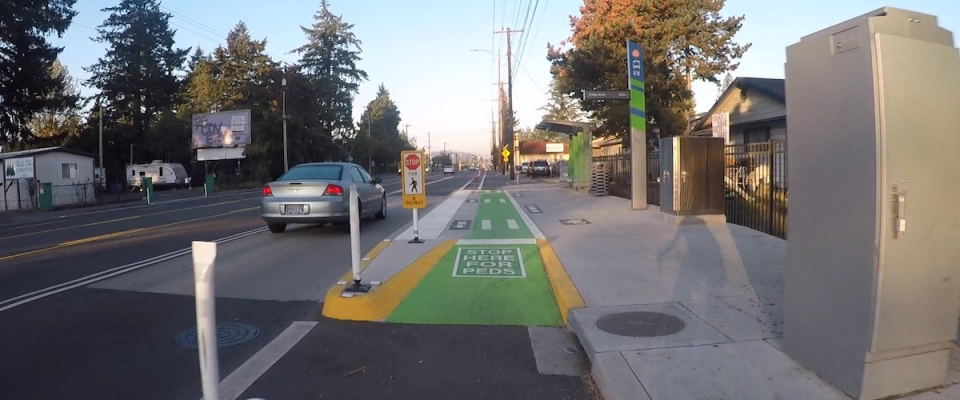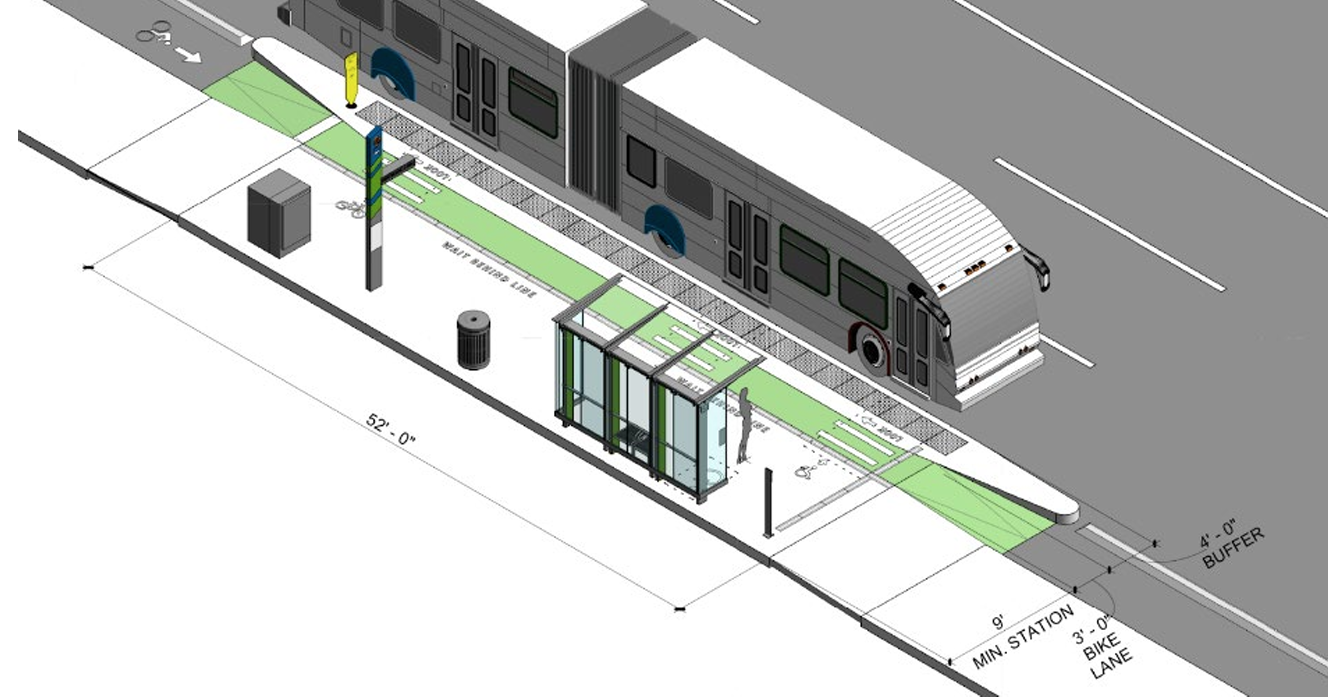Bikes and Transit Riders Sharing Space: Researchers Evaluate TriMet's New FX2 Bus Platform Design

Portland State University (PSU) researchers have partnered with TriMet to evaluate the design of a new shared-use bus platform that incorporates a sidewalk-level bike lane. The project, FX2 Shared Bicycle & Pedestrian Platform Evaluation, assessed how well the new design is working for transit riders and other road users along Portland's Southeast Division Street.
The most common bus and bike lane design typically has a bike lane directly adjacent to the right side of the bus lane with no physical barrier. This presents several safety concerns. In this scenario, a bike behind a bus would have to wait behind or pass the bus by riding into traffic. As vulnerable road users, these conflicts pose a potentially serious risk to bicyclists.
The FX2-Division is a Frequent Express (FX) bus line that runs from downtown Portland to Gresham. The transit service began operations in September 2022. To accommodate passing bicyclists and transit riders accessing the new FX2 line, TriMet worked with the City of Portland and a broad group of stakeholders and partners to create a design that would allow bikes to stay separated from automobile traffic, with the bikeway passing through the platform area next to where people wait for the bus.
The PSU research team consisted of Nathan McNeil and Jennifer Dill of the Transportation Research and Education Center (TREC), with Sirisha Kothuri and Christopher Monsere of the Maseeh College of Engineering and Computer Science (MCECS).
PSU has a good track record of working with the City of Portland and TriMet on innovative designs, including evaluations of the red bus lanes, separated bike lanes, bike signals and bike boxes.
"We love when cities do innovative things and try new ideas to overcome challenges. Division had been identified as an important bike corridor, transit route, and route for motorists. So a new bus platform needed to accommodate all the different users, without forcing bikes to move out into traffic and go into conditions where they felt unsafe. This design was an attempt to bring buses and bikes together without forcing either out into traffic; the tradeoff is that transit riders now are interacting with bikes. The main question behind our evaluation was, how are those tradeoffs working? Are there new risks that need to be considered, minimized, and accommodated for?" said lead researcher Nathan McNeil.
TriMet schematic of standard FX2 platform design
In addition to analyzing hours of video collected in the field, the research process also included surveys and interviews with people with low vision.
Key research questions included:
- How often are there conflicts between bicyclists and pedestrians, including near misses or collisions?
- What is the nature of the conflicts?
- How often do transit riders wait in the step-out zone or bike zone, instead of in the waiting area?
- How often do bicyclists stop at the stop bar (where the “stop here for pedestrians” sign is located) when a bus is at the stop?
- When bicyclists do not stop at the stop bar, do they still yield to transit riders getting on and off buses, do they go around buses, or behind the platform waiting area? •
- How do wheelchair users and people with vision impairments navigate the platforms?
Jesse Stemmler is the Design Manager and Urban Design Lead for TriMet's Division Transit Project. With the introduction of a new station typology, one which has potential application across the region, his team at TriMet approached the design process with intention. Partners from the TriMet Operations Group and its Committee on Accessible Transit, the Portland Bureau of Transportation (PBOT) Bicycle Advisory Committee, the PBOT Pedestrian Advisory Committee, the Oregon Commission for the Blind, the Oregon Department of Transportation, and local design firms all contributed input to the initial design of the new station.
Once it was deployed in the real world, the partnership with PSU continued the same spirit of rigor and commitment to implementing the best design for all road users.
"There aren't many opportunities in our world to be able to do this extensive amount of design study and then have that followed by real-world analysis and evaluation. So this work has been recognized as something very unique. It's not to say that everything in this design is perfect, but it represents a level of commitment to study and analysis of how we can more safely construct transit stops, where we're also accommodating bikes and pedestrians in these very constrained corridors. It is an important touchpoint, not only for how our region addresses transit and bicycle infrastructure, but it's now contributing to the national conversation in a meaningful way, " Stemmler said.
Some key overall findings from the analysis include:
- The primary conflicts which gave rise to the need for this design, including bikes moving out into automobile traffic, have been largely alleviated. Only 2% of bicyclists and other micromobility users used motor vehicle travel lanes.
- Bicyclists and other micromobility users rarely stop for transit passengers, but they do slow down when passengers and buses are present.
- Interactions between bicyclists and transit passengers generally occurred at slow speeds with each user aware of one another, negotiating for space.
- Some additional warning about when bicyclists are passing would be helpful, particularly for visually impaired transit passengers and pedestrians.
- Overall, surveyed FX2 passengers like the platform design. Green color was generally preferred for the bike lane.
- Inconsistency in design is a detriment for passengers with vision impairments.
ABOUT THE PROJECT
Portland State University's Transportation Research and Education Center (TREC) is a multidisciplinary hub for all things transportation. We are home to the Initiative for Bicycle and Pedestrian Innovation (IBPI), the data programs PORTAL and BikePed Portal, the Better Block PSU program, and PSU's membership in PacTrans, the Pacific Northwest Transportation Consortium. Our continuing goal is to produce impactful research and tools for transportation decision makers, expand the diversity and capacity of the workforce, and engage students and professionals through education, seminars, and participation in research. To get updates about what's going on at TREC, sign up for our monthly newsletter or follow us at the links below.
Facebook | Instagram | LinkedIn | TikTok | Threads | X | YouTube

